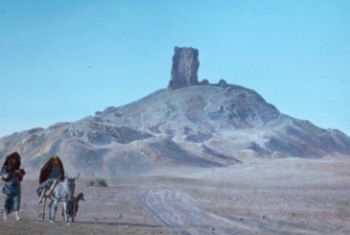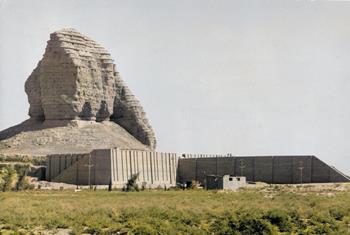 Edit article
Edit articleSeries
The Tower of Babel: A Polemic against Marduk’s Temple Esagil

A sketch highlighting the engraving on the so-called Tower of Babel Stele (ca. 600 B.C.E.), showing the image of Etemenanki, the ziggurat of Babylon, alongside King Nebuchadnezzar. Wikimedia
A Mesopotamian Story
Up until the story of the Tower of Babel episode in Genesis 11:1–9, the primeval history narrates a series of episodes in which humans are consistently moving or facing eastward (Gen 2:8; 3:24; 4:16). Here, humans move back toward the west to settle. From Israel’s point of view, moving west means approaching the Levant and “home.” Yet the story of Babel remains set in Babylonian territory:
בראשׁית יא:ב וַיְהִי בְּנָסְעָם מִקֶּדֶם וַיִּמְצְאוּ בִקְעָה בְּאֶרֶץ שִׁנְעָר וַיֵּשְׁבוּ שָׁם.
Gen 11:2 And as they migrated from the east, they discovered a plain in the land of Shinar, and they settled there.[1]
The toponym Shinar,[2] and the Hebrew biqʿah, translated here as “plain,”[3]—an apparent reference to the valley between the Tigris and Euphrates—locate the people’s stopping-place solidly on the alluvial plain that characterized Babylon’s—and not Israel’s—lived world.[4]
The people attempt to remain united by building a city and tower to make a name for themselves (v. 4).[5] Their construction materials—brick and bitumen—were common for monumental buildings in Mesopotamia, but not in the Levant, where stone and mortar were preferred:[6]
בראשׁית יא:ג וַיֹּאמְרוּ אִישׁ אֶל רֵעֵהוּ הָבָה נִלְבְּנָה לְבֵנִים וְנִשְׂרְפָה לִשְׂרֵפָה וַתְּהִי לָהֶם הַלְּבֵנָה לְאָבֶן וְהַחֵמָר הָיָה לָהֶם לַחֹמֶר.
Gen 11:3 Then, they said to each other, “Let us make bricks and let us fire them fully.” So they used brick for stone and bitumen for mortar.
The story thus explicitly translates the materials from one culture into another: “brick for stone and bitumen for mortar.”[7]
To prevent the city’s completion, YHWH confuses the people’s language so that they no longer speak the same tongue, leading humans to be dispersed across the world (vv. 5–8). The narrative ends with an etiology explaining the toponymבָּבֶל (Babel)—the Hebrew spelling of Babylon[8]—as a wordplay on the root ב.ל.ל, meaning “to garble or confuse”:
בראשׁית יא:ט עַל כֵּן קָרָא שְׁמָהּ בָּבֶל כִּי שָׁם בָּלַל יְ־הוָה שְׂפַת כָּל הָאָרֶץ וּמִשָּׁם הֱפִיצָם יְ־הוָה עַל פְּנֵי כָּל הָאָרֶץ.
Gen 11:9 Therefore its name is called Babel, because there YHWH garbled (balal) the language of the whole earth, and from there YHWH scattered them over the face of the whole earth.
Was Building the Tower a Sin?
At first glance, a “sin-and-punishment” motif seems to underlie the episode. Among the interpretations offered by scholars are:
- Human striving for fame caused them to rise against God.[9]
- Building a tower reaching heaven is the symbol of human hubris.[10]
- Human willingness to remain united against YHWH’s blessing, “be fruitful and multiply, and fill the earth” (Gen 1:28; 9:1), is hubris.[11]
The biblical account, however, nowhere explicitly accuses the people of sinning.
Which Tower Is the Bible Referring To?
Since Late Antiquity, interpreters have attempted to identify Babel’s tower with one of the known Mesopotamian ziggurats,[12] massive constructions of both fired and sun-dried mud brick, soil filling, and bitumen.[13] Several major Mesopotamian cities boasted at least one such structure,[14] the ruins of which were still visible even after the destruction of the cities. Possible candidates include:
Babylon’s Ziggurat – The most commonly reiterated theory is that the biblical tower was inspired in some way by Babylon’s ziggurat, Etemenanki (É-temen-an-ki: “House, Foundation Platform of Heaven and Underworld”),[15] which was a multi-stepped temple tower, composed of seven levels.[16] The ziggurat stood in the vicinity of Marduk’s temple, Esagil (É-saŋ-íl; “House [whose] Top is Raised High”).[17] According to the so-called Tower of Babel Stele that preserves the image of Etemenanki,[18] the ziggurat was built by Nebuchadnezzar II (605–562 B.C.E.)— infamous from a biblical perspective for his destruction of Jerusalem’s temple and society (2 Kgs 24–25).[19]
The ziggurat fell into disuse by the Hellenistic period and apparently turned into a pile of rubble. Some modern scholars argue that its ruins inspired the story of the Tower of Babylon.[20]

The Ziggurat of Borsippa – Writers from Late Antiquity onwards have regarded the ziggurat of Borsippa—Eurmeiminanki, “House which Gathers the Seven Mes of Heaven and Underworld”[21]—as the Tower of Babel. Its ruins still stand high in the Euphrates valley—over 50 meters above the plain (see fig. 1). As its modern name, Birs Nimrud, suggests, people also associated it with the biblical Nimrod known from Genesis 10.[22]

The Temple Tower at Dur-Kurigalzu – Visitors from the West likewise often believed—or were misled by the local people—that the ruin of the temple tower at Dur-Kurigalzu (modern Aqar-Quf) was the biblical Tower of Babel (see fig. 2).[23] Its ancient name is unknown, but at approx. 52 meters in height, its ruins are almost as tall as that of Birs Nimrud.
The Ziggurat in Sargon’s Capital City – Another theory views the ziggurat at Sargon II’s new capital, Dur-Sharrukin, as the model of the Tower of Babel. Like the city of Babel, Dur-Sharrukin was never completed.[24]
Yet scholars looking to connect the Tower of Babel to a particular historical ziggurat overlook the peculiarity of the description of the city in Genesis.
A City of One Tower
The city as described in Genesis has only a tower, and the Hebrew term migdal is used here as pars pro toto, where the tower symbolizes the entire city:
בראשׁית יא:ד וַיֹּאמְרוּ הָבָה נִבְנֶה לָּנוּ עִיר וּמִגְדָּל וְרֹאשׁוֹ בַשָּׁמַיִם וְנַעֲשֶׂה לָּנוּ שֵׁם פֶּן נָפוּץ עַל פְּנֵי כָל הָאָרֶץ.
Gen 11:4 Then they said, “Let us build ourselves a city, and a tower with its head in heaven, so that we may make a name for ourselves, lest we be scattered over the face of the whole earth.”
This focus on the tower as representative of the city as a whole has no historical parallel among the Mesopotamian cities, which would have included an array of noteworthy structures, including palaces, temples, city walls, and gates. It does, however, have a direct parallel, but in a literary source: the 12th century B.C.E. Mesopotamian myth Enuma Elish, also known as the Babylonian Creation Epic.[25]
I do not claim that the author(s) of the Tower of Babel narrative read or heard Enuma Elish in the original language, Akkadian, although we cannot reject such a possibility outright. It is possible that at least some Israelites encountered Enuma Elish in both word and ritual performance during annual festivals in which the myth was the most salient organizing feature, suggesting the Neo-Babylonian era as the likely period of Judean exposure to the text.[26]
Enuma Elish
Enuma Elish was composed to promote Marduk, the local god of the city of Babylon, as the new divine king, replacing Enlil, the traditional Mesopotamian supreme deity. It recounts how Marduk was deputized by the other gods to fight Tiamat, the divinized sea and divine matrix, and her army, who were threatening their existence.
Marduk is crowned king of the gods and he proceeds to create the world out of the body of Tiamat; the focus of this myth then turns to the construction of the city of Babylon. The myth thus canonizes Babylon as the new center of the world order and Marduk as the supreme god of the pantheon.[27]
The Tower Esagil
In Enuma Elish, the city of Babylon—not the historical Babylon, but Marduk’s mythological dominion, built by the gods—consists of one skyscraper: Esagil.[28] The Akkadian description of the tower in the text may be a gloss on the Sumerian name Esagil, which means “House [whose] Top is Raised High”:
EE VI 62 They raised the peak (ullu reshishu) of Esagil.
In this context, Genesis’ description of the Tower of Babel as rosho bashamayim, “with its head in heaven” (Gen 11:4), does not simply refer to the tower’s height, but is intended as an allusion to Enuma Elish and the importance of Esagil.[29]
A Polemic against the Babylonian Worldview
The biblical account of the Tower of Babel is a sharp polemic against the Marduk/Babylo-centric worldview. Enuma Elish claims that Marduk plans the construction of Babylon and his temple and humans build it, while the Tower of Babel story recounts that people plan the construction of the city and its tower without YHWH’s approval.
Enuma Elish also describes Babylon and Esagil as the permanent residence of the divine king Marduk and nexus of all the gods. Conversely, Genesis presents Babylon as the site of architectural failure. YHWH disperses people by confusing their languages in order to prevent the completion of the city’s and tower’s constructions (11:6–8).[30]
The Tower of Babel story calls Marduk’s temple a migdal, a term that typically refers to a tower or watch-tower as part of a fortification or citadel: in other words, a secular (even martial) tall building.[31] The authors thus reject the notion in Enuma Elish that Esagil, the deep-rooted skyscraper of Babylon, is a sacred structure built by the gods as the residence of Marduk and the gods.
By denying the Babylonian myth’s main thesis, i.e., Marduk’s newly established status as the divine ruler with Babylon as the center of the universe and the dwelling place of the gods, and the sacred origin of the city and its main temple, Genesis 11:1–9 rejects the Marduk/Babylo-centric worldview.
TheTorah.com is a 501(c)(3) nonprofit organization.
We rely on the support of readers like you. Please support us.
Published
November 2, 2022
|
Last Updated
December 3, 2025
Previous in the Series
Next in the Series
Before you continue...
Thank you to all our readers who offered their year-end support.
Please help TheTorah.com get off to a strong start in 2025.
Footnotes

Prof. Takayoshi M. Oshima is a visiting professor at the Institute of History of Ancient Civilizations, Northeast Normal University, China. He completed his doctorate in Assyriology at the Hebrew University in Jerusalem and a Doctor Philosophiae Habilitatus in Ancient Near Eastern Studies at the University of Leipzig. He specializes in Sumerian and Akkadian religious texts, the wisdom literature of the ancient Near East, including the biblical wisdom literature, and ancient Mesopotamian iconography. Among his publications are Cuneiform in Canaan (with Wayne Horowitz), Babylonian Poems of Pious Sufferers, Affronter le mal en Babylonie (with Stéphanie Antonioz), and Teaching Morality, the results of a conference he organized. Currently, he is preparing Gods’ Punishing Hands: The Interdependence of the Divine Will and Human Ethics in Cuneiform Literature, a revised version of his Habilitationsschrift.
Essays on Related Topics:









